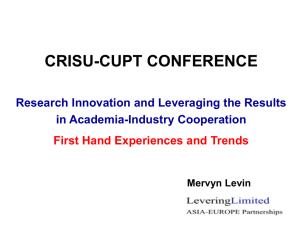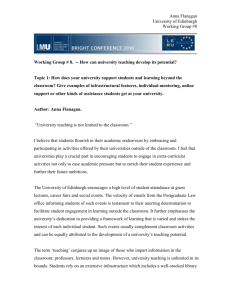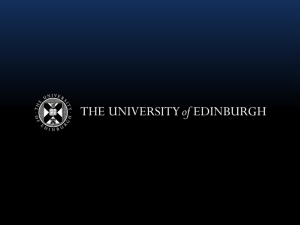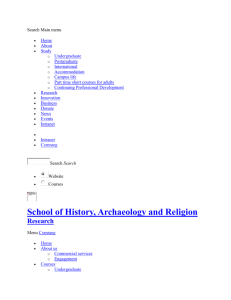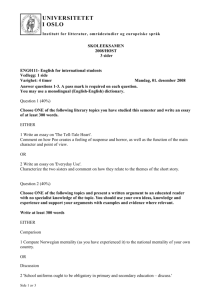`Valuing and supporting regional engagement activities` – by David
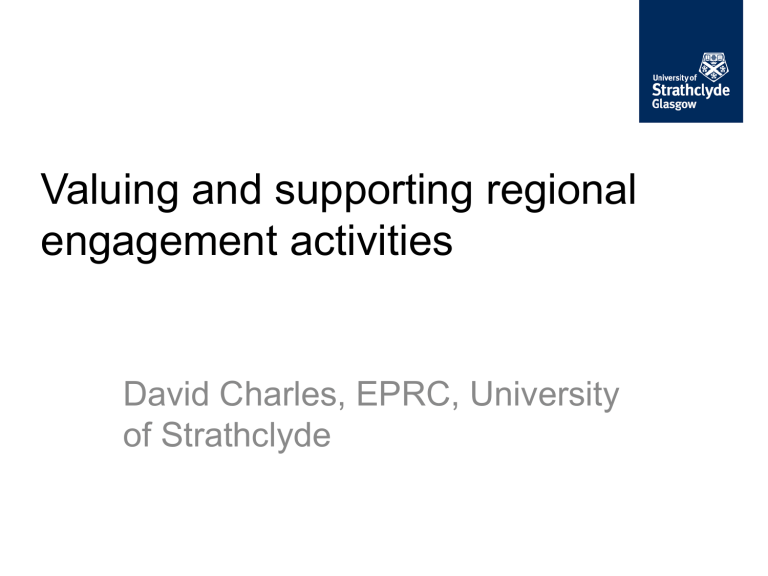
Valuing and supporting regional engagement activities
David Charles, EPRC, University of Strathclyde
Three main elements
• Making engagement visible
• Measuring activity
• Encouraging or rewarding engagement
– Mainly drawing on UK experience
Making engagement visible
• What do we include in engagement?
• Not just about business – regional development is more complex than that
• Includes regional sensitivity in core mission
• Voluntaristic activities
• Staff engagement – scholarship of engagement
• University strategic orientation - stewardship of place
Cycle of engagement
Building and strengthening requisite relationships with local partners
Increasing awareness of local partners regarding opportunities and resources available through the institution
Working proactively with those partners to identify needs and opportunities for engagement
Encouraging students and faculty to engage with community needs and rewarding such engagement
A hidden activity
• Unless universities audit these things then they usually don’t know how much is going on
• Much engagement falls into the individual category
• Central university policies can have perverse impacts on place and hence on the university
• Regional studies of engagement activity –
UK examples, OECD reviews
HEFCE/UUK Regional Mission project
• Capacity building project working with 9 regional HE associations – series of reports to make engagement visible
– Dynamic impacts on the competitiveness of the regional economy
– Impact on urban and rural regeneration
– Lifelong learning and employability
– The cultural agenda
– Social wellbeing and health
– Sustainability
– Contribution to regional institutional capacity
Measurement and assessment issues
• Qualitatively different to assess than teaching and research
• Not same consensus over idea of quality
• Not simply in control of university
• Does not indicate institutional excellence
• Partly dependent on external demand and environment
• Subjective assessment depending on perspective
Different forms of KT and RE
• Different paths to KT – research exploitation or informal exchange
• KT as codified vs tacit knowledge – who benefits?
• Other forms of engagement – cultural, social, governance relationships etc
• Are we assessing university or regional environment?
• Varied possible forms of excellence, some easier to measure than others
Simple exploitation measures
• Patents, licences, spin offs, contract income
• Discipline-specific opportunities and partly demand driven
• Example of HEBCIS survey in UK, AUTM in US and Canada
• Different rankings of universities for different indicators
Universities with the highest number of spin offs where the university has some ownership in
2007/8 and in 2010/11
6
7
8
4
5
1
2
3
9
10
11
12
13
University ranking 2007/8
University of Leicester
Imperial College London
University of Leeds
Liverpool John Moores University
University of Bradford
Napier University
Brunel University
University of Ulster
University of Newcastle upon Tyne
Robert Gordon University
University of Birmingham
University of Edinburgh
De Montfort University
University ranking 2010/11
14
Loughborough University
11
Royal College of Art
8
Heriot-Watt University
7
The University of Leicester
7
Coventry University
7
The University of Plymouth
7
The University of Bradford
7
The Institute of Cancer Research
5
University College London
5
Edinburgh Napier University
4
Cranfield University
3
The University of Hull
3 Imperial College of Science, Technology and Medicine
17
18
19
20
14
15
16
Royal College of Art
University of the Arts London
University of Manchester
University of Strathclyde
University of Hertfordshire
University of Durham
University of Hull
3
3
3
3
3
3
3
The University of Oxford
University of Hertfordshire
The University of Liverpool
Middlesex University
The University of Newcastle-upon-Tyne
The University of Edinburgh
University of Durham
5
5
5
4
6
5
5
9
7
7
14
11
15
15
15
6
6
7
7
6
Most active universities for graduate start ups
Number of graduate startups 2007/8
University for the Creative Arts
De Montfort University
Royal College of Art
Kingston University
University of Central Lancashire
University of the Arts London
University of Bedfordshire
University of Wales Institute,
Cardiff
University of Portsmouth
University of East Anglia
University of Derby
160 Kingston University
147 Royal College of Art
140 The University of Central Lancashire
131 University College Falmouth
126 Cardiff University
115 The University of Portsmouth
112 University of Bedfordshire
69 De Montfort University
65 Teesside University
54 Loughborough University
53
The Manchester Metropolitan
University
40 University of Derby Leeds Metropolitan University
University of Northumbria at
Newcastle
Southampton Solent University
Bournemouth University
39 The University of East Anglia
31 Cardiff Metropolitan University
28 University for the Creative Arts
Number of graduate start-ups 2010/11
113
96
96
95
89
85
179
160
158
127
114
65
61
61
60
Benchmarking instead of ranking
• Comprehensive set of indicators
• Identify areas of strength and weakness
• University and partners to decide on prioritisation
• Benchmarking with other universities to learn how to improve those areas seen as important
• Differentiation as an objective to better meet needs of stakeholders
Engagement embedded in university vision and mission
1
Vision and mission does not recognise engagement as a key role for the university
2 3
Some reference to the need to engage with the region is placed in the vision or mission, usually in terms of identifying a regional community as being of interest. Vision is developed from a topdown position and is not driving strategy or seen as an influence on staff behaviour.
4 5
Engagement is a central element of the vision and mission and is the result of a sophisticated debate within the institution involving staff from various levels of the institution.
Engagement is seen as part of the DNA of the university and is considered as important in everything they do.
Rewarding and valuing engagement
1
No staff incentives for engagement
– positive discrimination against engagement in promotions processes with an emphasis on research.
2 3
Formal recognition of engagement in promotions procedures as one of the areas of performance that can be recognised, but little evidence of it having major impacts on behaviour. Little recognition elsewhere in the system.
Engagement is tolerated and possibly rewarded where excellence is achieved but not systematically.
4 5
Clear and well communicated recognition of engagement in a wide range of staff policies.
Engagement is supported through workload and line management and good performance is recognised in promotion and through salary. Resources are available to help staff develop engagement skills including study leave.
University recognises scholarship of engagement.
Encouragement of engagement
• Government support and funding for engagement
• University strategies, policies and incentives
• Development of a culture or scholarship of engagement
UK Government initiatives in 2000s
• DTI white paper in 1998, ‘Building the Knowledge Driven Economy’
• 12 Science Enterprise Centres through the Science Enterprise
Challenge
• Cambridge-MIT Institute (CMI)
• University Challenge Fund with funding from the Treasury,
Wellcome Trust and Gatsby Charitable Foundation
• Higher Education Reach Out to Business and the Community
– launched 1999 - first tranche of £60 million for three-year projects in 87 institutions or consortia: second round £22 million in 2000 with 50 awards (11 collaborative projects)
• University innovation Centres, large, regionally-based, research and innovation centres often focused on collaboration between
HEIs e.g. nanotechnology in Newcastle
• Higher Education Innovation Fund
• RDA initiatives through ‘single pot’
• Different schemes in Scotland, Wales and NI
And more….
• Lambert review strengthens understanding of the regional role
• RDAs with Science Councils and new centres of excellence
• HEFCE support for further regional collaboration
• Active Community Fund
• Science Cities
• Beacons of public engagement – then
Catalyst programme
• Catapult centres
University internal changes
• Boundary spanning units
• Promotion criteria and parallel career tracks
• Senior management roles
• Specialist strategic engagement units
• KE and engagement strategies
• New campus concepts
Creating a culture of engagement
• It already exists to some degree among academic staff
• Needs formal recognition and support
• Capacity building is a key element
• Careful with assessment as will skew activity
• Use measurement to achieve wider goals, not to create rankings for the sake of rankings
